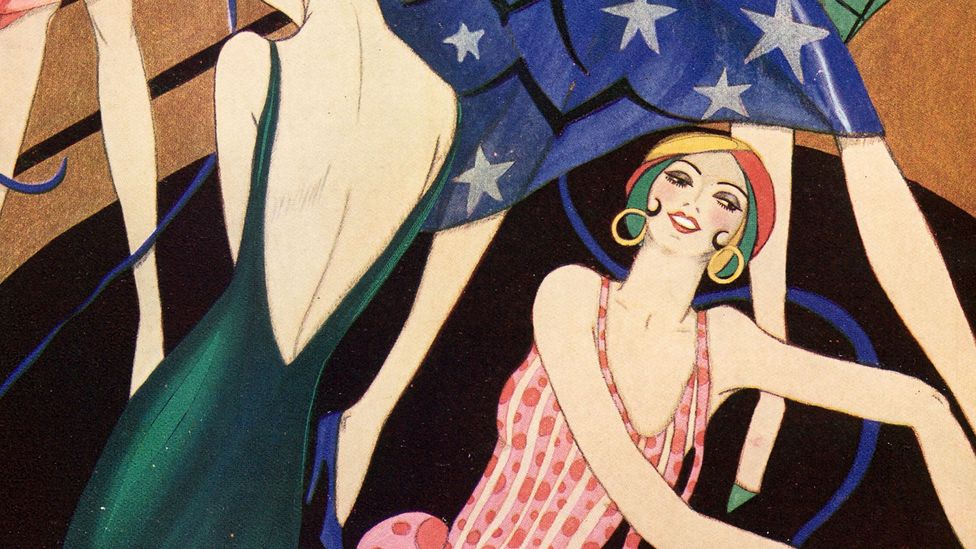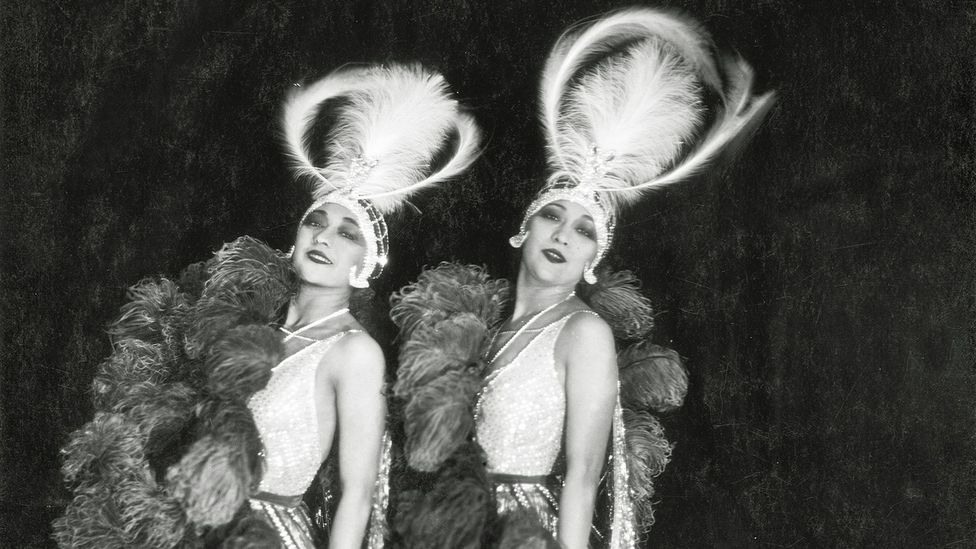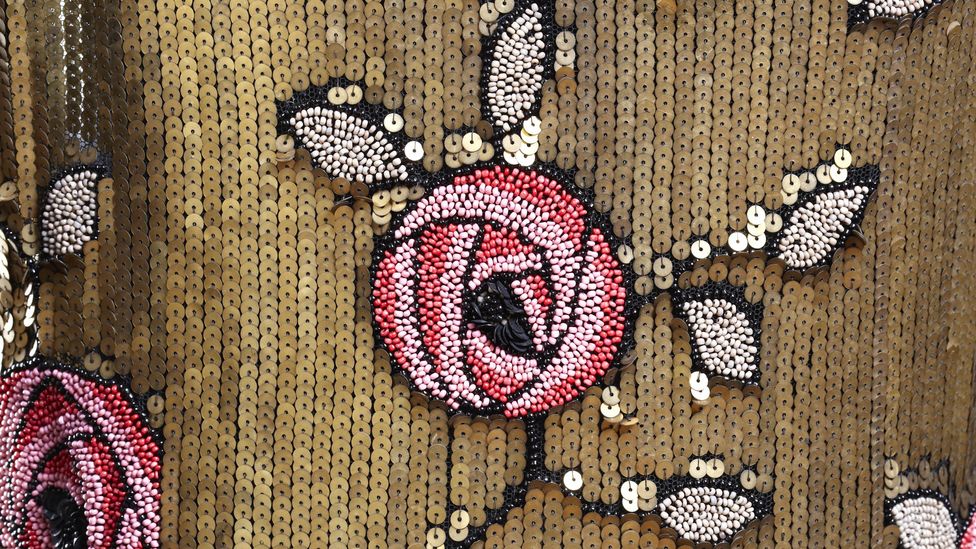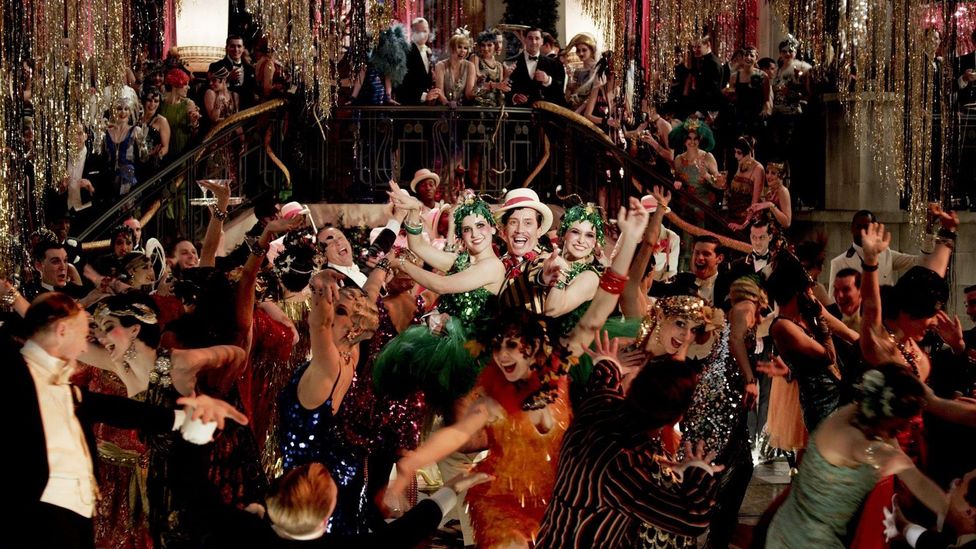Popular Culture of the 1920s Fashion
The wild era that changed what we wear
(Epitome credit:
London News Ltd/Mary Evans
)

The Jazz Age was a wild era that changed the manner we wearing apparel and how we live our lives to this twenty-four hours, writes Lindsay Baker.
"It was an age of miracles," F Scott Fitzgerald wrote in his essay Echoes of the Jazz Age. "It was an age of art, it was an historic period of excess." In his fiction, the author beguilingly captured the sybaritic Roaring 20s – hedonistic, glamorous, decadent, opulent. Photographs and illustrations from the era reflect this seductive, dazzling sense of wildness and fun – flapper girls grin ecstatically and dancing with carelessness in their swishing, tasseled dresses and bobbed hair, or posing in tumbling marabou boas and towering feathered head-dresses.
"There is a constant sense of rhythm and femininity and glamour," says Dennis Nothdruft, who has a special involvement in 1920s fashion, and is curator at London's Fashion and Textile Museum. "There's a sense of club crashing into the modern age, with motion and speed and romanticism." So how and why did the 1920s 'roar'? And what made the Jazz Age so unique – and influential?

The Dolly sisters were twins who came to recap the extravagance of the 1920s – they were paid $ane,200 a nighttime to appear at the Moulin Rouge (Credit: James Abbe Annal)
The speed of change during the 1920s was dizzying. Booming prosperity and social upheaval combined with a youthful, post-war euphoria and new female empowerment to make the 1920s paradigm-shifting, boundary-busting decade. "The generation before them had been slaughtered in the war, and there was a devil-may-intendance mental attitude," Nothdruft says. And like the musical genre it was named later on, the Jazz Age was total of unruly spontaneity, improvisation and edginess. "Jazz was the sound of the '20s, and the rhythms and beats of the music permeate the visual."
Sin and spectacle
The 1920s was when "the modern woman'due south wardrobe began," Nothdruft says. Out went the tight corsets and bustles of the Edwardian era, equally did the long, hugely impractical dresses, elaborate hair styles and hats of that time, and in came the shorter, drib-waisted dresses and easy-to-manage bobbed hairstyles. Silk pyjamas became popular for lounging, entertaining at dwelling house or for the beach, with chinoiserie and Egyptian styles particularly popular in clothing and jewellery – the latter due largely to the blockbuster exhibition of King Tut'southward tomb in 1922. Coco Chanel even took to wearing trousers. What began as a niche, bohemian youthquake soon trickled downwardly. The fashions became pervasive and the bobbed hairstyles de rigeur among the general female population, and with them a sense of liberation and confidence.

Once the corset was discarded, body-covering dresses were replaced past loose-plumbing equipment ensembles with lower necklines – and shocking materials like sequins (Credit: Tessa Hallman)
And now that the motion picture was emerging, the new trends could attain more people faster than e'er before. Hollywood was bursting into the popular consciousness with an explosion of movie palaces going up across the globe, and massive stars coming into their ain – like the glamorous Gloria Swanson in her elaborate head dresses and rebellious 'it girl' Clara Bow.

Lawn tennis player Suzanne Lenglen won the gilded medal in the women's singles competition at the 1920 Olympics and exemplified the '20s sportswoman (Credit: Wikipedia)
In the extravagantly ruffled robes de fashion by Lanvin and in the ubiquitous feathered boas, fringes and tassles, in that location was a new feeling of dynamism – perfectly captured by American illustrator Gordon Conway, herself a flapper career girl, whose work encapsulates the music, sensuality and glamour of the time. "These dress were made to move and dance in, and the capes with huge collars and no structure literally fell off the wearer as she moved," says Nothdruft.
A new sense of speed and movement pervaded culture – crucially the motorcar had arrived, and even lawn tennis became racey. "There was an explosion of athleticism," says Nothdruft, whose exhibition devotes a section to the sportswear of the era. Women's lawn tennis had previously been a genteel pastime, with ladies in long dresses and heavy petticoats drifting daintily effectually a lawn. Only in the 1920s the first female star of tennis, French thespian Suzanne Lenglen, was transforming the women's game with her tough, fast playing style (considered by some commentators 'unladylike') and her diva-ish ways. She e'er arrived courtside in a fur glaze, whatever the conditions, and played in mod flapper outfits – dogie-length, slim-silhouetted silk dresses in red or orange. She also had a trend to smoke and drink cognac on the court – to steady her fretfulness, she said. She shocked the oversupply past serving overhead, and became known every bit 'the Goddess'.
Breaking the mould
It was also the showtime time that mannish styles became fashionable. "There was a trend for women wearing tuxedos and tailored suits. Coco Chanel borrowed hers from her boyfriend along with fisherman'southward sweaters and tweeds," says Nothdruft. "And lesbianism was also fashionable for the kickoff time, certainly in café society in Paris, London and New York." Among the stylish, talented lesbian stars of the era were painter Romaine Brooks and her partner, the writer Natalie Barney, forth with the poet and author of The Well of Loneliness, Radclyffe Hall. Women similar these helped prepare the agenda for the decades that followed, and their chic, androgynous style has proved enduring – androgynous dressing and masculine tailoring for women have appeared at regular intervals over the subsequent decades, and at present, most a century on, the wait is in one case again enjoying a renaissance, at French characterization Céline in item.
In New York it was the era of the Harlem Renaissance, with a wave of creative energy from black artists, musicians and writers, notably author and social activist Langston Hughes, one of the earliest innovators of jazz poetry. Meanwhile in Europe racial boundaries were increasingly being challenged, with African-American jazz musicians widely feted, and the talented and flamboyant cabaret dancer Josephine Baker becoming an icon of the era.

F Scott Fitzgerald's The Cracking Gatsby immortalized the era – right downward to its inclusion of a Lenglen-esque sportswoman in the character Jordan Baker (Credit: Warner Bros)
It was a time of liberation and boundary breaking, says Nothdruft: "The career woman was born, and for the first fourth dimension women could choose not to marry. Young women were working in the day, and were out un-chaperoned in Chinatown dens, jazz clubs and speakeasies." The party lasted for 10 years and and so, as Fitzgerald put it: "leaped to a spectacular death in Oct 1929". Glittering but tragic, beautiful and damned, the emotionally bankrupt lost generation – this is how the Jazz Agers have often been depicted. But in its mood and its aesthetic, not to mention its sheer progressiveness, the Jazz Historic period remains arguably the nearly beguiling and culturally influential era of them all. And fun while it lasted. Every bit Fitzgerald wrote in Echoes of the Jazz Historic period, his essay for a 1931 outcome of Scribner's Magazine: "Subsequently two years the Jazz Age seems equally far away equally the days before the State of war. Information technology was borrowed time anyway – the whole upper tenth of a nation living with the insouciance of grand ducs and the casualness of chorus girls. Merely moralizing is easy now and it was pleasant to be in 1'southward twenties in such a certain and unworried fourth dimension."
If yous would similar to annotate on this story or anything else you have seen on BBC Civilization, head over to our Facebook folio or message united states on Twitter .
And if you lot liked this story, sign up for the weekly bbc.com features newsletter , called "If You Only Read half-dozen Things This Week". A handpicked pick of stories from BBC Futurity, Globe, Culture, Capital, Travel and Autos, delivered to your inbox every Friday.
0 Response to "Popular Culture of the 1920s Fashion"
Post a Comment